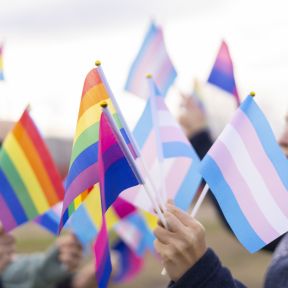Media Coverage and Suicide Contagion
Suicide is devastating and alarming; to some people, it is also fascinating. The suicide of a high-profile individual or of a celebrity can trigger a flurry of news stories, gossip, and speculation. Fictional stories often explore the theme of suicide or use it as a plot point.
Even though a fascination with suicide is natural and understandable, evidence suggests that excessive or irresponsible coverage of suicide can, in some cases, lead vulnerable individuals to more strongly consider taking their own life. This phenomenon, known as suicide contagion, is almost never solely due to media coverage of a suicide or a certain fictional representation of the act; suicide contagion is also possible via real-life exposure to a community suicide, absent media coverage altogether. However, given the heightened role the media plays in modern life, researchers posit that portraying suicide in responsible, straightforward ways—and emphasizing that help is always available—can help minimize the risk and better educate the public about suicide.
For immediate help in the U.S., 24/7: Call 988 or go to 988lifeline.org. Outside of the U.S., visit the International Resources page for suicide hotlines in your country. To find a therapist near you, see the Psychology Today Therapy Directory.
Few would expect the media to ignore high-profile or otherwise newsworthy suicides, and it's natural for artists to incorporate suicide-related themes into movies, books, TV shows, and other forms of entertainment. But how suicide is depicted in these mediums is a key factor in how it will be received and how it will affect the emotional well-being of its audience. If presented irresponsibly, evidence suggests it can have serious, and potentially deadly, effects.
In recent years, suicide prevention organizations have outlined guidelines to ensure media outlets are conveying information about suicide and self-harm in safe, responsible ways. Though there's yet a long way to go, research suggests that significant progress has been made.
Mainstream news media organizations have long been criticized for their coverage of suicide, often accused of romanticizing or sensationalizing the act and potentially triggering viewers who are thinking of hurting themselves. But experts caution that any individual's path to suicide is highly complex, and while media coverage may indeed be a factor, it is far from the only one.
Suicide is often due to a confluence of overlapping circumstances, such as mental illness, economic circumstances, or trauma. In some cases, there is evidence that media coverage may intensify the risk. A large recent review, for example, found that suicide rates tend to increase immediately after media coverage of a high-profile suicide; it appears to increase even further if reporting guidelines designed to reduce harm—such as not reporting the method used in the suicide—are not adhered to. But it may be that just learning about a suicide—regardless of how it’s covered by the media—could lead to suicide contagion among already-vulnerable individuals.
Public health organizations around the world have devised a series of guidelines to help media entities write about suicide in a way that is less likely to trigger vulnerable individuals or promote suicide contagion. The recommendations include:
• News organizations should avoid sharing unnecessary details about the means or method of suicide. Reporting on the death itself is sufficient; if a suicide note was left, its specific contents should not be shared publicly.
• Reporters should aim to avoid language that criminalizes suicide or inflates its prevalence. Phrases like “committed suicide,” though commonly used, are thought to make suicide seem like a criminal act; public health experts recommend saying “died by suicide” or “killed him/herself” instead. Similarly, using phrases like “suicide epidemic” can overexaggerate suicide’s prevalence and may lead vulnerable people to believe that suicide is commonplace or acceptable. Suicide rates have risen for many groups, and the media cannot ignore such statistics; however, reporting the facts without hyperbole is the best way to protect those who are at risk.
• Reporters should focus on the deceased’s life, not just their death. Photographs, if included with a story, should aim to place the deceased in a positive light; photographs of the location or of visibly distraught loved ones are not advised.
• News organizations should always include information about suicide prevention resources, such as suicide hotline numbers, crisis text lines, local emergency numbers, or other relevant resources.
The phrase “committed suicide” is often used colloquially to describe someone taking their own life. However, suicide prevention researchers posit that the word “commit” implies a criminal action, which may stigmatize suicide or make it appear shameful or immoral. Instead, the American Foundation for Suicide Prevention recommends saying the more neutral “died by suicide,” “completed suicide,” or “killed him/herself.”
Evidence suggests that in recent years, media organizations have gotten better at implementing many of the above guidelines when reporting about a suicide; however, experts caution that there remains significant room for improvement. One 2020 analysis, for instance, examined a large sample of Canadian news articles about suicide, finding that more than 80 percent did not use sensationalized language or discouraged words such as “committed suicide.” However, less than 1 in 4 articles included suicide prevention resources, and 40 percent reported the suicide location and/or method. Articles about high-profile suicides appeared least likely to adhere to the guidelines.
Modern movies and television shows like “13 Reasons Why” have renewed debates about whether media that glamorizes suicide could encourage vulnerable people to attempt it themselves. But the debate actually dates to well before the invention of film—at least to the 1700s, when the novel The Sorrows of Young Werther was accused of causing a spike in suicide deaths among young European men. (To learn more, see The Werther Effect, below.)
Copycat suicides—or suicides that emulate another, often highly-publicized suicide—are widely considered to be a real phenomenon. But whether copycat suicides occur because of a particular piece of fictional media isn’t always clear-cut, and experts disagree on the influence of fictional depictions of suicide. Data published after the release of “13 Reasons Why,” for instance, appeared to show a rise in youth suicide rates following the show’s release. But the findings were criticized by some, in large part because the youth suicide rate had been on the rise long before the show first aired.
On the other hand, one oft-cited meta-analysis concluded that real suicides, rather than fictional ones, appeared most likely to inspire copycat deaths. Most experts still caution that media depictions of suicide should be approached responsibly, however—especially when the intended audience is young or otherwise considered more easily influenced.
The television show “13 Reasons Why,” based on a popular teen novel, caused a furor among mental health experts when it was released. Since it graphically depicts a teen girl taking her own life, some worried that it would lead to a wave of copycat suicides among young people. The character also publicly blames others for her death in a series of audiotapes, which experts worried would send the message that taking one’s own life could be an effective means of revenge.
However, there is little evidence suggesting that “13 Reasons Why” was directly responsible for any increases in teen suicide. Data showing heightened youth suicide rates after the show’s release was criticized for not taking into account the already-existing increase in suicide among this age group, and controlling for seasonal fluctuations in suicide rates indicated that the risk of suicide did not increase after the show’s release. Some additional data further suggest that for some children, watching the show was associated with reduced depression and suicidal ideation.
Social media is often perceived as a negative influence, but its connection to suicide is neither all good nor all bad. On the one hand, social media can foster hostility, aggression, and cyberbullying, which can damage someone’s mental health; it may also draw vulnerable individuals to groups that promote or encourage suicide. On the other hand, social media can build connections between people and may give isolated or lonely individuals the opportunity to confide in or seek help from distant others. Frank discussions of mental health that often appear on social media may help reduce the stigma surrounding suicide. What’s more, teens and young adults report an increased willingness to seek help via social media, while being less comfortable with in-person help.
Suicide isn't "contagious" the way the common cold is. But decades of evidence do suggest that vulnerable individuals can be negatively influenced by another's suicide, and in some cases may be primed to take their own life as a result. Because of this so-called "suicide contagion," experts recommend that communities affected by suicide take preemptive steps to protect vulnerable group members in the wake of a tragedy.
Suicide contagion—or an increase in suicide attempts and completed suicides following exposure to someone else’s suicide, either via the media or one’s personal social circle—is a well-documented phenomenon. However, experts caution that while many studies have found a correlation between exposure to a suicide and increased suicide rates, it’s not possible to say whether a specific exposure caused subsequent suicides; in the vast majority of cases, it’s very likely that a confluence of other factors were at play.
For an at-risk individual, learning about a completed suicide may make the idea of suicide more prominent in their mind. Conversations or reports about the suicide that glamorize the death or that provide overly simplistic explanations (implying that suicide solved the individual's problems, or was a logical response to a specific negative life event) may present a falsely positive impression of suicide and may lead someone to view it as a more viable course of action.
Suicide clusters are most commonly seen in people under the age of 25, suggesting that adolescents and young adults—whose brains are still in the process of developing and who may be more likely to struggle with questions of identity—may be most vulnerable to suicide contagion. Other groups that appear to be at heightened risk include psychiatric inpatients, prison inmates, military veterans, or members of minority groups that are experiencing economic or cultural discrimination.
The term “copycat suicide” refers to a suicide that occurs after and is at least partially inspired by another suicide, either of somebody in the individual's direct orbit (such as a friend or family member) or in society at large (such as a celebrity). In many cases, a copycat suicide will be carried out by someone in the same demographic as the original suicide; the copycat may also use the same method.
The so-called “Werther effect” refers to a spike in copycat suicides after a widely-publicized suicide (real or fictional). The effect takes its name from a popular 1774 German novel called The Sorrows of Young Werther, which depicted the main character dying by suicide as the result of unrequited love. The book purportedly inspired many copycat suicides among young European men; some of the dead were reportedly found with the book by their side. In the 1970s, suicide researcher David Phillips coined the term “the Werther effect” to describe the phenomenon of copycat suicides inspired by a media portrayal. While some experts today caution that reports of a post-Werther suicide bump were based mainly on anecdotal evidence, were not systematically tracked, and may themselves have been sensationalized, the idea that there can be a spike in copycat suicides following a high-profile death is generally accepted among researchers.
The “Papageno effect” is the opposite of the Werther effect. It describes the positive effects that responsible portrayals of suicide can have on suicide prevention efforts, by reassuring vulnerable individuals that help is available and/or that there are alternatives to suicide. Coined by researcher Thomas Niederkrotenthaler, the effect was named for the character Papageno in Mozart’s “The Magic Flute,” who becomes suicidal but decides not to take his own life after other characters help him see other ways to solve his problems. Niederkrotenthaler’s research has concluded that news stories that emphasize positive coping strategies in response to suicidal ideation appear most likely to spur the Papageno effect.
After a community suicide, experts recommend additional outreach and “debriefing” sessions for those deemed to be at risk for potential contagion. If a high school student dies by suicide, for example, providing additional support to other students in the days and weeks following is imperative for stemming the possibility of suicide contagion. Debriefing should include grief counseling and information on where affected individuals can seek help if they are experiencing suicidal thoughts. Group and individual counseling should be considered if possible.
When a celebrity dies by suicide, the media coverage can often be relentless—digging into the celebrity's mental illnesses, wounded relationships, financial troubles, and on and on. Such coverage undoubtedly rewards media organizations with eyeballs and clicks, but its effects on readers and viewers can be far from beneficial. Indeed, evidence suggests that people repeatedly exposed to information about celebrity suicides may be at significant risk of negative emotional outcomes—as well as, in some cases, a heightened risk of suicidality themselves. Thus, it's important for media outlets to limit the amount of coverage they devote to a celebrity suicide—or, barring that, that audience members set boundaries on how much coverage they will and will not consume.
Celebrity suicides often garner extensive coverage that other deaths do not, which may create the impression that famous people kill themselves at unusually high rates. However, most celebrities who died by suicide also displayed other risk factors—such as mental health disorders, relationship struggles, or past trauma—and it’s not always clear whether fame itself further increased their risk.
What is known, however, is that being successful or famous cannot make someone immune from suicide. Even celebrities who seem to live glamorous, happy lives could be struggling with deep inner turmoil.
Celebrity suicides can be shocking and painful for a number of reasons, especially if the celebrity was especially beloved or did not appear to be in mental distress. Since fame is typically presented as desirable—and because famous people are often portrayed as living exciting, carefree lives—many people mistakenly believe that celebrities “have it all” or have no reason to be unhappy. When a seemingly glamorous, well-off individual dies by suicide, it can be difficult for members of the public to make sense of the decision or reconcile their preconceived notions of the person’s life. It may also trigger a sense of fear or futility. If even a famous and wildly successful person would feel compelled to take their own life, some might wonder, what does that mean for the rest of us?
Many people also form one-sided connections with celebrities—known as parasocial relationships—and may come to identify with them or feel as if they know them. Most of the time, these one-sided relationships are not harmful. However, if the celebrity takes their own life, it can trigger significant feelings of grief that may, in some cases, be comparable to the grief one might feel if someone they knew in real life died. But due to persistent societal misconceptions that it’s inappropriate or “weird” to grieve someone that you don’t know personally, many people who experience grief at a celebrity’s death may feel as if their feelings are inappropriate, unnecessary, or even embarrassing, which can further add to their emotional turmoil.
High-profile or celebrity suicides have been associated with suicide contagion in several studies. This effect is usually short-term (occurring in the weeks or months after a suicide) and appears particularly heightened when the method of suicide is reported in the press or if the death is especially widely publicized. For this reason, suicide prevention organizations recommend that media outlets do not report the method used in the suicide, include information about suicide hotline numbers or additional resources in every story, and limit coverage to reasonable amounts (rather than repeating the story over and over).
It’s common to feel distressed, confused, or deeply saddened by a celebrity suicide. This can be especially heightened in those who were big fans of the celebrity or who shared some aspects of their identity—someone who was the same age as the deceased, for instance, or shared the same mental health struggles, may find themselves fixated on the death, even if they weren’t especially familiar with the celebrity’s work. Such grief may feel disenfranchised—someone may feel as if they can’t talk about the grief or worry that others will think they’re overreacting.
But this response is common and valid, and certain strategies can help someone cope. To start, experts often recommend limiting media consumption about the death; while reading multiple news stories about the suicide may feel like a useful coping mechanism, it may actually make the idea of suicide more prominent and lead to unhealthy rumination. Next, those grieving a celebrity suicide often find it helpful to connect with friends or engage in a comforting activity. It’s OK to talk about the death with loved ones, if it’s helpful—it’s also OK to request that conversation focus on different, happier topics. If the grief persists for weeks or months, or is accompanied by suicidal thoughts, it’s OK to seek help—either from suicide hotlines or a mental health professional. To find one near you, visit the Psychology Today Therapy Directory














